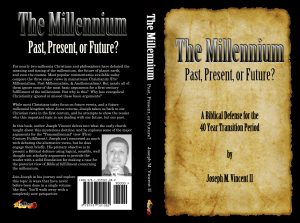
I concluded the first installment in this series on the passing of heaven and earth and the end of the Millennium by taking note of the following:
“It is at that Great Judgment that heaven and earth passes. It is at that judgment that the martyrs are vindicated. To put this another way, heaven and earth pass away at the vindication of the martyrs.” We turn our attention now to looking at this issue a bit closer.
The Destruction of Creation, Resurrection and the End of the Millennium – #2
Let’s look closer at this in another text that discusses the passing of heaven and earth. This alone should inform us, in light of Jesus’ paradigmatic teaching on the vindication of the martyrs, that the end of the Millennium -the passing of “heaven and earth – was in the first century.
Let’s return to the issue of the passing of heaven and earth in another text in Revelation.
Revelation 16:4-7, 18-20 –
“And the third angel poured out his vial upon the rivers and fountains of waters; and they became blood. And I heard the angel of the waters say, Thou art righteous, O Lord, which art, and wast, and shalt be, because thou hast judged thus. For they have shed the blood of saints and prophets, and thou hast given them blood to drink; for they are worthy. And I heard another out of the altar say, Even so, Lord God Almighty, true and righteous are thy judgments. Then the seventh angel poured out his bowl into the air, and a loud voice came out of the temple of heaven, from the throne, saying, “It is done!” And there were noises and thunderings and lightnings; and there was a great earthquake, such a mighty and great earthquake as had not occurred since men were on the earth. Now the great city was divided into three parts, and the cities of the nations fell. And great Babylon was remembered before God, to give her the cup of the wine of the fierceness of His wrath. Then every island fled away, and the mountains were not found.”
We have here the exaltation and praise of the Lord for His righteousness in judging the Great Persecutor, Babylon, the Harlot city. I would call attention to the fact that in verse 7, the altar sings praises to the Lord for His vindication. This takes us back to chapter 6:9f and the souls under the altar who cried out for vindication. Chapter 16 is another view of their vindication, and we are told that it is Babylon that was the slayer of the prophets and servants of the Lord. More on chapter 6 later.
There is more here. Back in chapter 15:8 we were told that John saw the Ark of the Covenant in the Temple, but, he was informed that no man could enter there, the Most Holy Place, until the wrath of God contained in the seven vials of God’s wrath was completed. In chapter 16 we see the outpouring of those bowls, and the seventh and final bowl is poured out against Babylon, the great persecutor. In her judgment, “the cup of the wine of the fierceness of His wrath” i.e. the Great Day of the Lord’s Wrath, would come. This is, of course, the Great Day of the Lord’s Wrath of Revelation 6:12f that – just as here in chapter 16:7f, is the answer to the prayer of the saints for vindication. Thus, the Great Day of the Lord’s Wrath against Babylon is the time of the vindication of the martyrs. And that means that it is the Great White Throne Judgment of Revelation 20:10f – that occurs at the end of the Millennium.
In this judgment, we are told “every island fled away, and the mountains were not found.” The language might not be as “expansive” as “heaven and earth” in Revelation 20, but, we need not make the mistake to think that two separate judgments, two separate vindications of the martyrs, at two separate Great Days of the Lord are in view. This is typical Hebraic manner of expression. There is no rule of journalism that demands that every expression, every exact wording be used from text to text. That is specious. But, after all, if the mountains are not found, and if the islands have fled away, that is “earth shattering” to be sure.
Of course, the key issue here is Who Is This Babylon? The evidence here is all but overwhelming: Babylon of Revelation was none other than Old Covenant, first century Jerusalem. It is the city that had slain the prophets. It is “where the Lord was crucified.” It is the city guilty of killing the apostles and prophets of Jesus (18:20-24). Just as Jesus and Paul said, Jerusalem was filling the measure of her sin and would be judged and destroyed in the first century, Babylon’s cup of sin was full and her judgment was at hand and coming soon. See my book, Who Is This Babylon? for an extensive demonstration that Babylon of Revelation was Jerusalem.

So, in Revelation 16, we have the destruction of creation, the removal of the islands and the mountains, at the time of the vindication of the martyrs, in the judgment of Babylon, the city where the Lord was crucified. What we will see in Revelation 6 is that the entire premise of this study, and that is that the heaven and earth would pass away at the vindication of the martyrs, occurred at the fall of Jerusalem in AD 70. This means that the end of the Millennium was in the first century. Stay tuned, as we continue our examination of the passing of heaven and earth and the end of the Millennium. In the meantime, be sure to get a copy of Joseph Vincent’s book, The Millennium: Past, Present or Future?

Source: Don K. Preston
